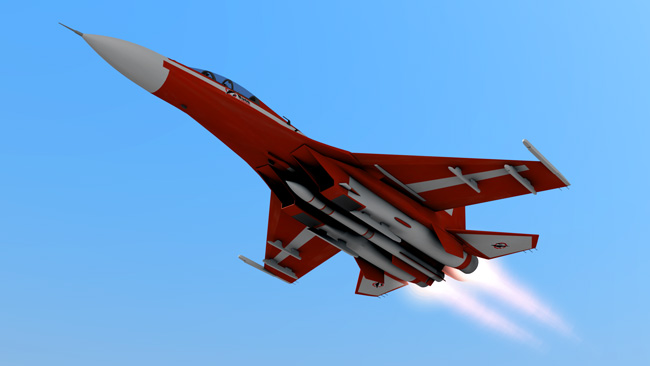Recycled Military Jets Serve as Satellite Launchers

Spaceis quicklybecoming a less remote place as dozens of universities andorganizations prepareto launch small satellites in the coming years. For now, however, thesemini-satellitesmust piggyback their way as secondary payloads, meaning operators havelittlecontrol over the timing of a launch or on reaching a desired orbitalaltitudefor their mission goals.
Anumber ofcompanies aim to eliminate these when and where-to whims ? not tomentioncutting down on costs -- by offering dedicated smallsatellite launching services.
"Gettingreasonable cost access [to space] for small spacecraft is reallycritical,"said Kris Kimel, president of Kentucky Space, a private-publicconsortiumwaiting for its first smallorbital satellite to be launched in 2011. "We need to getthat kind ofaccess that allows us to relentlessly innovate and quite frankly tofail more."
Arecent entrantinto this emerging field is NanoLauncher. The startup will rely ondecommissioned military jets outfitted with a rocket to send relativelytinypayloads into suborbital and orbital flight paths. [Photo ofNanoLauncher'ssatellite-launching jet]
Theventure willinitially operate out of the United States at established spaceports,such asNASA's Kennedy Space Center in Fla., Wallops Flight Facility inVirginia andVandenberg Air Force Base in Calif.
NanoLauncherplansto use existing technologies rather than create its own rocket orsatellitedeployment systems, said A.C. Charania, president of SpaceWorksCommercial,based in Washington, D.C. His company is working with three Japanesefirms ? IHIAerospace, the Institute for Unmanned Space Experiment Free Flyer, andCSPJapan, Inc. ? to get NanoLauncher off the ground.
Charaniaand othersin his line of work envision the small satellite marketplace booming inthe yearsto come.
Get the Space.com Newsletter
Breaking space news, the latest updates on rocket launches, skywatching events and more!
"We'reridingthe nanosatellite wave," Charania said. "It's not an illusion."
Essenceof aminiature satellite
Smallsatellitesare generally characterized as weighing less than 330 pounds (150kilograms),though the majority of those built or slated fall under the categoriesof nanosatellite(under 22 pounds, or 10 kg) or picosatellite (under 2.2 pounds, or 1kg).
Themost popularform factor is the CubeSat, a 3.9-inch (10 cm) cube weighing no morethan 2.9pounds (1.33 kg) that has become the industry standard since one firstflew in2003.
Buildingand placinga CubeSat into orbit has historically cost somewhere between$50,000 and$150,000, according to Jordi Puig-Suari, professor of aerospaceengineering andCubeSat Project Co-Director at Cal Poly who helped developed themore-or-lessinternational standards for CubeSats a decade ago.
Thesediminutive satellitesare very different from conventional satellites used for science andcommunications, which often weigh hundreds of pounds, are the size of acar,cost millions of dollars to build and launch and take years to go fromthe drawingboard into service.
Formanyapplications, traditional satellites will remain the standard. Butsmallsatellites are becoming increasingly more capable, driven by the sametechnology advances that are making personal computers and smartphonesincreasingly powerful.
"Smallerthings in the 21st century are capable of doing so much more," Charaniasaid.
Smallsatellites, whichcan range in shape from a square box to a loaf of bread, have so farbeen usedfor research purposes such as Earth observations, remote sensing andbiologyexperiments. Universities worldwide have all gotten in on the smallsatellitecraze, as well as companies such as Boeing, and NASA's thirdnanosatellitemission is set for later this year.
ClydeSpace, amajor supplier and manufacturer of small satellite components, hasconservativelypredicted that the number of CubeSats launched will jump from around 50todayto more like 500 by the end of the decade.
Shootingsatellites into the blue and black
NanoLauncherintends to be there as this market continues to mature and expand.
Jetsunderconsideration for the NanoLauncher game plan include the Lockheed F-104Starfighter and the McDonnell Douglas F-15D Eagle, among others. Thesefighterswill take the payload ? slung underneath the fuselage on a rocket ?severalmiles up and then fire the rocket to send the stowed satellites totheirintended destination above the Earth.
NanoLauncher'ssuborbitalservices will be rendered under the brand name NanoLauncher Blue (sonamed for"blue skies") and orbital insertions will fall under NanoLauncherBlack, named for the "black" of space.
Forthe latterservice, NanoLauncher has advertised sending a maximum of 44 pounds (20kg)into a high, circular 155-mile (250-km) orbit, although pricing isstill beingworked out.
Perits existingtechnology philosophy, NanoLauncher will make use of the standarddeploymentsystem developed at Cal Poly and Stanford University known as the polypicosatellite orbital deployer, or P-POD. This spring-loaded instrumentcan depositthree standard-size CubeSats into space, but is modifiable for varioussize andshape payloads.
NanoLauncherBlue isexpected to begin full-scale operations in the 2014 time range andBlack sometimein 2015.
Acrowding field
Otherorganizationshave an eye on the microsatellite market as well. Interorbital Systems,aMojave, Calif.-based aerospace firm involved in the Google Lunar XPrize and spacetourism, will soon begin test flights of its Neptune modular rocketthat mightsend small satellites aloft as soon as March 2011.
InterorbitalSystems offers CubeSat launches for the very low price of $12,500,sells itsown cylindrical "TubeSat" kits (with an included launch) for just$8,000, and on top of this has plans to establish a spaceport on thePacificisland nation of Tonga.
Theradicallydifferent approaches ? jet plane-and-rocket combos from existingfacilities inNanoLauncher's case to proprietary in-house rockets shooting skywardfrom a privatepad in Interorbital System's ? show just how wide open the arena is forthefuture of small satellite launchservices.
Inrecognition ofthis, NASA is expected to announce details in the coming months for itsNano-Satellite Launch Challenge. This X Prize-style,innovation-promoting contestwill award $2 million to the winner who can launch a CubeSat,essentially, intoa complete orbit twice in one week.
RandaMilliron, CEOand co-founder of Interorbital Services, told SPACE.com that hercompany willbe entering the competition. SpaceWorks Commercial has also expressedinterestin signing up NanoLauncher as well.
"Wehope thiswill all lead to a lot of space science and a huge amount of fun foreveryone," said Milliron. "It's exciting to be the enabler."
- Top10 Private Spaceships Becoming Reality
- 6Private Companies That Could Launch Humans Into Space
- TinySatellites Can Do Big Science
AdamHadhazy isa Staff Writer for TechNewsDaily,aSPACE.com sister site.
Join our Space Forums to keep talking space on the latest missions, night sky and more! And if you have a news tip, correction or comment, let us know at: community@space.com.

Adam Hadhazy is a contributing writer for Live Science and Space.com. He often writes about physics, psychology, animal behavior and story topics in general that explore the blurring line between today's science fiction and tomorrow's science fact. Adam has a Master of Arts degree from the Arthur L. Carter Journalism Institute at New York University and a Bachelor of Arts degree from Boston College. When not squeezing in reruns of Star Trek, Adam likes hurling a Frisbee or dining on spicy food. You can check out more of his work at www.adamhadhazy.com.









